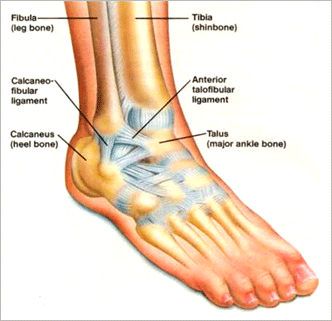Your feet are always holding the weight of your entire body. So its no wonder why they hurt sometimes……
However, typically in many cases, they shouldn’t because your ankle consisted of tough bones carefully formed to balance thestresses and burden and should usually prevent excess pressure. Your ankles are a combination of hard bones and flexible articulations that work together simultaneously every time you take a step forward. However, sometimes, this flexibility makes it a soft spot for joint pain.
Ankle pain is often dull and poorly located, and there are various causes such as arthritis, gout, and ankle sprain. However, what if you can identify your ankle pain precisely in front of the articulation? What is located there, and what could it possibly be?
What is located in the front of your ankle?
The front of your ankle contains bony structures, tendons, nerves, and blood vessels. All of them can be affected or injured in various ways. Find out more about Ankle Pain from BMI Healthcare UK
The bony structures in this region are the lower portion of the tibia and the fibula.
Right in front of these bony structures run down a series of tendons extending to the toes. They are called tibialis anterior, extensor hallucis longus, and extensor digitorum. These tendons attach to the toe bones and move them according to the commands of the muscles above.
Between the tibialis anterior tendon and the extensor hallucis longus tendon runs down a blood vessel (anterior tibial artery) and a nerve (deep peroneal nerve).
If your pain is not dull and dispersed in a large area but located in the front of your ankle, your doctor will probably try to rule out a traumatic event or an injury to one of the structures we mentioned above. But what is happening and what can you do about it?
CHECK BEST PRICE FOR ANKLE PAIN HELP AMAZON UK
Causes of pain in front of the ankle
There are various causes of pain in the anterior aspect of the ankle. In order of importance and frequency, they are as follows:
- Anterolateral Ankle impingement: This apparently complicated wording simply means that an excess of either bony tissue or soft tissue is causing interference to the regular movements of the ankle joint. Every time you flex your ankle, the joint meets this excess tissue, and your range of motion feels limited and painful. This may appear in patients who underwent an ankle sprain and neglected their condition. The tissue does not heal properly and instead grows an excess tissue that limits ankle flexion.

- Degenerative joint disease: Either arthritis or osteochondritis causes swelling and pain in the front of the ankle. The articulation is stiff, and it may have either a mechanical or inflammatory cause. Osteochondritis is also common in patients with a previous ankle sprain who were not correctly treated and developed microscopic fractures in severe cases.
- Tendonitis: Out of the three tendons we mentioned early, the most commonly affected is the tibialis anterior. This one runs down to reach the toes and passes straight in front of the ankle. In runners and people who use this articulation excessively or heavily (as in morbid obesity), this tendon becomes inflamed, the whole area goes through swelling, and nerve terminals are stimulated to deliver continuous pain that exacerbates by flexing the articulation. In tibialis anterior tendonitis, pain and tenderness are felt especially when touching the area of the tendon while at the same time flexing your ankle.
- Fractures or subluxation: It is also possible to experience a subluxation, fractures, or stress fractures in the area of the ankle with subsequent pain sensation upon moving the articulation. Similar to the ailments we have mentioned above, these cases are commonly associated with heavy use of the articulation. However, this time, there is usually an acute episode of trauma, ankle twisting, or fall related to the start of the symptoms.
Improving ankle pain and what you should avoid
As you have probably noticed, ankle impingement, tendonitis, and fractures are associated with heavy use of the articulation, and some cases of degenerative joint disease in the ankle have a similar origin. It is a similar condition to Peroneal Tendonitis. Thus, if you’re having pain in front of your ankle, it is highly likely your putting much load in the articulation of your ankles.
If you’re a runner or have the daily habit of jogging, this might be due to overuse of the articulation. Similarly, other activities like aerobic dancing and leg exercises might be triggering this condition. Even if you don’t have much physical activity, overweight and obesity might be increasing the loads in the articulation, and seemingly small strains contribute a big deal to the problem at the end of the day.
All of the causes we have described above have something in common: they need appropriate rest to improve the pain symptom. Thus, stop dancing, running, and doing any activity that contributes to flexion and extension of the ankle. Resting your articulation for 4 weeks should be enough in severe cases, but in milder pain, you might start feeling better before that time.
You can apply ice and only resume physical activity when there is no pain at all. Over-the-counter medications help a big deal in reducing inflammation, and in some severe cases, your doctor might consider appropriate to schedule a rehab program or even apply a plaster cast. Thus, do not neglect your condition and talk to your doctor about your symptoms to know specific recommendations according to your case.
It should also be a good idea to identify altered foot biomechanics by visiting an orthopedist, especially if you’re overweight or obese. The whole flexing pain might be triggered or worsened by an altered use of muscles or pressure points in your feet. Thus, you might start feeling better by using special padding in your shoes.
How can I stop and prevent the Pain at the Front of my Ankle?

Thus, if you have experienced this bothering symptom, chances are you will be back on track very soon. The most common conditions are called ankle impingement, degenerative joint disease, tibialis anterior tendonitis, and fractures or subluxation. All of them are associated with heavy use of the articulation, as in running, dancing, doing aerobics or certain leg exercises, especially if you’re overweight or obese. Thus, according to your case, follow the advice of your doctor and only resume physical activity once your symptoms are fully resolved.
References:
Liu, S. H., & Nguyen, T. M. (1999). Ankle sprains and other soft tissue injuries. Current opinion in rheumatology, 11(2), 132-137.
Robinson, P., & White, L. M. (2002). Soft-tissue and osseous impingement syndromes of the ankle: role of imaging in diagnosis and management. Radiographics, 22(6), 1457-1469.
Robinson, P. (2007). Impingement syndromes of the ankle. European radiology, 17(12), 3056-3065.

I have been feeling this pain for a long time near the front of my ankle. I was worried about that you see so I was going to call my local surgery. I read you article instead! Jolly good!
Will likely be back to get more. Thanks
Steven
Your welcome Steven.
Happy to help
Dr. Matthew Warburton